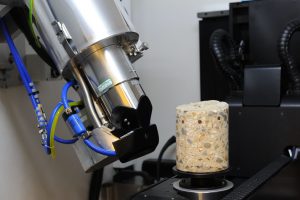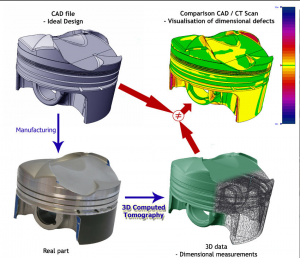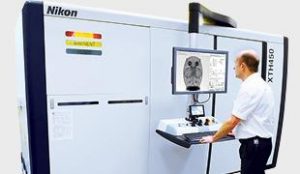Gómez points out that the field of CT metrology still faces challenges in trying to estimate measurement uncertainties, “mainly due to the plethora of influencing factors contributing to the CT measurement process.” His thesis attempts to further understand the role of variables affecting the precision and accuracy of CT dimensional measurements. The main CT variables he investigates are temperature in the X–ray CT enclosure, number of projections for a CT scan, workpiece tilt orientation, sample image magnification, material thickness influences, software post–filtration, threshold determination, and measurement strategies.
In some experiments, Gómez contrasted the results against simulations performed in Matlab software and another simulation tool called Dreamcaster.“For dimensions of geometric features ranging from 0.5 mm to 65 mm, a comparison between dimensional CT and CMM measurements, performed at optimized conditions, typically resulted in differences of approximately 5 µm or less for data associated with dimensional lengths(length, width, height, and diameters) and around 5 to 50 µm for data associated with measurements of form, while expanded uncertainties computed for the CT measurements ranged from 1 to over 50 µm,” he states.
He also assessed methods for estimating measurement uncertainty of CT scanning. He presents a thorough study of metrics used for proficiency testing, including tests of statistical consistency (null-hypothesis testing) performed with Monte Carlo simulation, and applies them to results from two recent CT interlaboratory comparisons.
Gómez’s study is important when applied to additive manufacturing because, particularly in fields such as aerospace, precision of parts is of the utmost importance. A flawless method of measurements must be established, and CT scanning has great potential, and is indeed already in widespread use. But it’s not perfect, as Gómez points out, and his thesis attempts to assess and better understand its limitations.“In particular, it is shown that the use of the En-metric in the current state of CT interlaboratory comparisons could be difficult to interpret when used to evaluate performance and/or statistical consistency of CT measurement sets,” he continues.
One of the benefits of additive manufacturing is that it can create parts with complex geometries, both internal and external, and those can be difficult to measure, especially non-destructively. QA for 3D printing is still problematic for many parts. CT scanning is a largely reliable method for measuring the complicated internal channels and features that additive manufacturing is known for, and Gómez’s work is a big step toward making it even more reliable.
Discuss this and other 3D printing topics at 3DPrintBoard.com or share your thoughts below.
Subscribe to Our Email Newsletter
Stay up-to-date on all the latest news from the 3D printing industry and receive information and offers from third party vendors.
You May Also Like
Printing Money Episode 18: The DC Fly-In with Mark Burnham, AddMfgCoalition
It’s only been a week since the previous show, but Printing Money is back already with Episode 18. Certain events call for Printing Money’s coverage, and the recent 2nd Annual...
3DPOD Episode 199: Collaborative Design with Graham Bredemeyer, CEO of CADchat
About a decade ago, entrepreneur Graham Bredemeyer started Collider, a company that combined the best of 3D printing with injection molding. Now he runs CADChat, which hopes to make sharing...
Printing Money Episode 17: Recent 3D Printing Deals, with Alex Kingsbury
Printing Money is back with Episode 17! Our host, NewCap Partners‘ Danny Piper, is joined by Alex Kingsbury for this episode, so you can prepare yourself for smart coverage laced...
3DPOD Episode 198: High Speed Sintering with Neil Hopkinson, VP of AM at Stratasys
Neil Hopkinson, a pioneering 3D printing researcher, played a pivotal role in developing a body of research that is widely utilized today. He also invented High Speed Sintering (HSS), also...




































